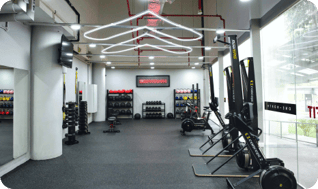Back exercises are sometimes overlooked by newcomers to the gym when planning a programme–is that because they’re less visible in the mirror? We’re unsure. But we are certain that understanding the purpose of back muscles and how to train them correctly is essential–and not just for aesthetics!
Why bother with back exercises?
Your back muscles are among the largest and most important in your body and play a key role in stabilising your spine and helping you perform daily activities. Keeping these muscles strong helps maintain good posture and allows you to lift, pull, and move around more easily.
When we talk about back muscles, we’re referring to three main areas:
- The upper back: Including the trapezius, rhomboids, and rear deltoids, supports shoulder movement and stability.
- The middle back: The latissimus dorsi, or "lats," are the winged muscles on the sides of the torso that help with pulling movements.
- The lower back: The erector spinae that supports spinal stability and the core.
Strengthening these areas of the back will help you build a shapely and powerful physique that supports common activities, such as lifting groceries and opening doors.
Types of back exercises
To work these areas of the back, we can group exercises into three main types: Pulling, deadlift and hinging, and isolation.
Pulling exercises
Exercises such as pull-ups, lat pulldowns, and row variations are the cornerstone of any well-rounded back workout. They’re great because they typically target multiple areas of the back simultaneously.
A key benefit of pulling exercises is their modifiability. For example, if pull-ups are too challenging, you can instead use a lat-pulldown machine to provide a similar movement pattern with adjustable resistance. Similarly, if bent-over rows are too stressful on your lower back, you can switch to a chest-supported or seated cable row to reduce the stress.
That’s not to say pulling exercises don’t come with challenges. Your grip will never be as strong as your back, so grip strength is commonly a limiting factor, especially for beginners. Accessories like lifting straps can help, but those with weaker grips will always have an annoying distraction when trying to maintain proper form.
Our tip for pulling exercises
- Beginners: Start with 3 sets of 8–12 repetitions with a light-to-moderate weight, focusing on maintaining good form and slowly increasing resistance over time.
- Veterans: Opt for 4 sets of 6–10 repetitions with a heavier weight to build strength or a moderate weight with higher reps to improve endurance.
Deadlift and hinging exercises

Deadlifts and hinging exercises comprise a wide array of deadlift variations (conventional, sumo, Romanian, etc.) and good mornings, all of which are fundamental movements for strength training.
These exercises primarily engage the lower back, glutes, hamstrings, and core muscles. This efficiency makes them an excellent choice for building the size of back muscles and functional strength. Why? Because hinging is so prevalent in daily life–whenever you bend down to lift or carry things!
However, these exercises are technique-intensive; proper form is crucial to avoid damaging your lower back. Maintaining a relatively straight spine and avoiding excessive rounding while hinging is essential to avoid strain on the lower back and hamstrings.
Our tip for pulling exercises
- Beginners: Start with 3 sets of 5–8 repetitions with a lighter weight. Consider professional coaching to master the movements before progressing to moderate weights.
- Veterans: Programme a variety of deadlift and hinging variations. Focus on lower repetitions with heavy weight to build overall strength and muscle.
Isolation exercises
Isolation exercises–also called “accessories”–are single-joint movements that focus on a single muscle group. These include face pulls, reverse flyes, pullovers, back extensions, and more that target smaller areas of the back to support compound exercises (those that engage multiple muscle groups simultaneously).
Isolation exercises allow you to address specific weaknesses without heavily engaging other muscle groups. They tend to be joint-friendly, which makes them great for refining form, improving imbalances, and recovering from injuries. However, they are less efficient for overall strength building and can inflate the time you spend in the gym each workout.
Our tip for pulling exercises
- Beginners: Start with 3–4 sets of 10–15 repetitions per isolation exercise. This will allow you to target smaller back muscles without causing excessive fatigue.
- Veterans: Isolation exercises should be programmed to address specific weaknesses. For example, if your back rounds excessively during deadlifts, back extensions could help strengthen your erector spinae alongside targeted core exercises.
How to programme back exercises

Programming back exercises isn’t complicated but thoughtful planning is required to maximise results. Understanding which back exercises to include in a dedicated back workout or as part of a full-body routine can help you achieve a muscular back.
Which is right for you?
Deciding whether to do a dedicated back day or incorporate them alongside other exercises is a matter of preference and prioritisation.
Back day
If you want to prioritise back development, dedicating a day solely to back exercises is a great way to focus on targeting all areas of the back–upper, middle, and lower–and address any weaknesses or imbalances. As a general rule, you should perform a vertical pulling movement, a horizontal pulling movement, a hinging movement (or deadlift), and an isolation exercise.
Of course, this means you’ll have to commit a little more time each week to ensure you’re working on other important muscular groups and not doing so much that you risk fatigue or overuse injuries.
A dedicated back day should include both compound and isolation exercises–here’s a sample routine:
- Deadlifts for overall back strength.
- Lat pulldowns (or pull-ups) for lat development.
- Single-arm dumbbell rows for mid-back thickness and to address imbalances.
- Face pulls to isolate the rear deltoids.
- Back extensions to build endurance in the lower back.
Full-body workout
A full-body workout is a great option if you attend the gym less frequently (fewer than twice weekly) and still want to work most major muscle groups.
This method allows for greater recovery between workouts but won’t target the back as comprehensively or intensely as a dedicated back day. In addition, it may require more programming experience to sequence exercises safely and effectively.
Focus primarily on compound back exercises, perhaps with an isolation exercise that you can do depending on your weaknesses. Here’s what you could include:
- Deadlifts for overall back strength.
- Lat pulldowns (or pull-ups) for lat development.
- Face pulls to isolate the rear deltoids.
Building an effective back routine
Building a strong and muscular back requires you to understand which exercises are suitable for your fitness level and will help you achieve your goals.
Our team of experienced coaches is adept at guiding clients through exercises ensuring proper form, technique, and modifications to suit your ability. By allowing us to help you create a back programme, you’re creating a foundation for ongoing success in your training and committing to lasting good health.


.png?width=301&height=187&name=Website%20Navigation%20Images%20(3).png)

-1.jpg?width=1984&height=1196&name=UFIT%20Club%20Street%20Front%20(4)-1.jpg)





%20How%20to%20get%20a%20muscular%20back%20-%20Blog%20banner%20image.webp?width=300&name=Baby%20got%20back%20(muscles)%20How%20to%20get%20a%20muscular%20back%20-%20Blog%20banner%20image.webp)
